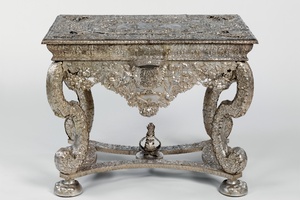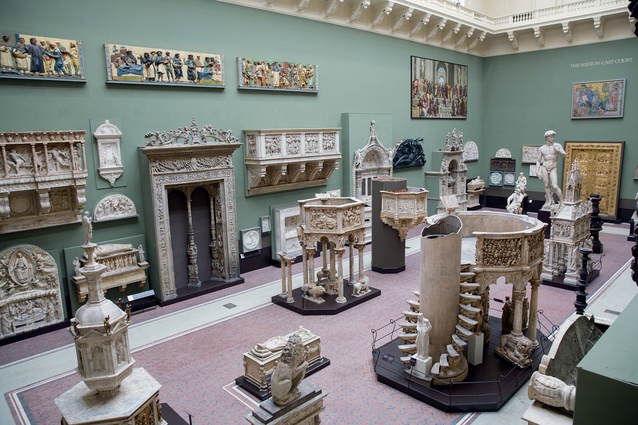The replica factor
Replicas, knock-offs, copyright violations… call them what you will but they are as old as art itself. Brendan Cormier and Dr Danielle Thom explore some of the history and future of the controversial practice. Could their findings have resonance in the world of industrial and furniture design? We believe they do…
The history of the copy is as old as the history of art itself. The copy can be employed as a forgery, or used to share the beauty of the original. From ancient Rome to the present day, the copy has fascinated artists and audiences alike, for it plays with our ideas of value, authorship and genius. Only recently, with the advent of new technologies, has the copy taken on a new perceived value: preservation.
It’s this change that forms the focus of A World of Fragile Parts, an exhibition for the first Pavilion of Applied Arts at the 15th Venice International Architecture Biennale, co-produced by the Victoria and Albert museum (V&A) and the Biennale. But how did we come to see this new value? Hold tight: a short history lesson follows.
Many of the marble statues which art historians now acknowledge as the finest examples of antique sculpture were, in fact, copies – including the Apollo Belvedere, the Laocoön and Hissons and the Venus de’ Medici. By the 18th century, a canon of the best antique sculptures had been determined, and these were copied in bronze and plaster for the benefit of wealthy European collectors.
Then, as the spirit of the Victorian age tended towards notions of public improvement, Sir Henry Cole, first director of the South Kensington Museum (as the V&A was then known), took upon himself the task of introducing great works of art and architecture to his visitors, regardless of their status. In an age when travel was prohibitively expensive, plaster-cast copies were the best way to represent the majesty of immovable great works of art abroad. In 1867, Cole drafted a document that formalised the process of obtaining copies from the great museums of Europe, and from notable architectural sites.
From its foundation until the early 20th century, the V&A amassed an array of copies in a variety of media, including photography and electrotyping. The latter, a now-obscure technology, is essentially a means of making copies in metal, which involved forming a mould of the item to be replicated, coating this in powdered graphite to make it conductive, and dipping it in an electrolyte solution. This solution, through which an electrical current was run, contained copper sulphate: the copper atoms would adhere to the graphite coating, forming a perfect impression of the original.

Many of the architectural casts in the museum’s collection became more valuable with time, such as those representing buildings that have since been damaged or demolished. However, by the dawn of the 20th century, the age of Modernism and mass production, the copy no longer expressed the beauty of the original, but cheapened it. The V&A’s Cast Courts remained as relics of a bygone era, while other cast collections in Europe met a more decisive end. So it might have continued were it not for a new impetus and a new suite of technologies: the need to preserve, married with the growth of digital scanning and fabrication.
Digital fabrication, in the form of 3D printing and CNC milling, has, until very recently, been the highly specialised preserve of engineers and scientists. The increasing accessibility of these technologies is exciting, and, in the context of cultural preservation, it couldn’t be timelier. Violence in the Middle East, particularly the destruction of Palmyra, Syria, and Mosul, Iraq, at the hands of ISIS, has brought the risks faced by many of our most significant sites and objects into public conversation. Similarly dangerous are the risks posed by longer-term processes of destruction: climate change, natural disaster, urbanisation, tourism and neglect.
As well as showcasing many of the V&A’s historic copies, A World of Fragile Parts displays some of the most significant contemporary projects engaging with the copy and deploying it as a strategy for preservation. Some have responded directly to the ISIS crisis, ranging in scale from the Institute for Digital Archaeology’s massive reconstruction of Palmyra’s destroyed Triumphal Arch, to artist Morehshin Allahyari’s small resin prints of objects lost in the destruction of Mosul. These objects each have a USB memory stick physically embedded within them, on which the 3D digital file is stored, so in theory they could be perpetually remade.
Artist Andreas Angelidakis is concerned with the physical reproduction of internet ruins, while David Gissen copies the voids within structures by capturing acoustic impressions. The effort is global – the Zamani Project, based at the University of Cape Town, is producing high-resolution 3D models of important African heritage sites – and it reconfigures our understanding of what deserves to be copied, such as the architect Sam Jacob’s efforts to scan structures from the Calais ‘Jungle’ refugee camp.
This project, in particular, underscores the urgency inherent in A World of Fragile Parts. The fragility in question is not only one of material objects and structures, but also of human lives and experiences. Copying doesn’t just reconstitute the physical, it allows for cultural, emotional and political survival as well.
A longer version of this article first appeared in the Summer 2016 issue of V&A Magazine. Brendan Cormier and Dr Danielle Thom are curators at the Victoria and Albert Museum. A World of Fragile Parts, 15th Venice International Architecture Biennale, runs until 27 November 2016.











